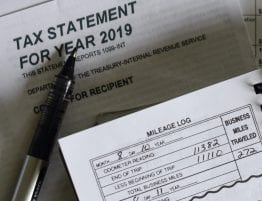
The 2023 tax season is upon us. Tax preparation starts as early as January 3rd, 2023 however, the IRS typically makes the official announcement that they will start accepting returns by the end of January. Individuals and owner-operators must file their taxes or request an extension by the deadline of April 15, 2023.
Do you know what tax forms you need to complete and what deductions you might be eligible for? Whether you want to find a CPA to do your taxes or plan to do them yourself, it is wise to stay current on the IRS’s latest tax guidelines and offered plans for tax relief. Keep reading for our guide to learn all about how to file your taxes in 2023.
What Tax Forms Do I Need to File my Tax Return?
When filing your taxes, it is important to understand the different tax forms you need to complete and submit to file your return. Whether you are filing as an individual or a business, there are several different forms that you may need to use to report your income and deductions properly. We’ve conveniently listed out all of the common forms below.
Key IRS Tax Forms Needed for Filing Returns
- Form 1040: This is the most common form used by individuals to file their taxes with the Internal Revenue Service (IRS). It is used to report your income, deductions, credits, and other factors related to your tax return.
- Form 1040-SR: This form is for seniors aged 65 and over using the same schedules as form 1040.
- Form 1040-NR: This form is used by individuals who are not U.S. citizens or resident aliens, such as foreign students and scholars. It reports income from wages, salaries, tips, dividends, and other sources.
- Form 1040-ES: This form is used by self-employed individuals to calculate estimated taxes. It can also be used to report income from investments, rental property, and other sources.
- Form 1099: This form reports income from sources such as interest, dividends, capital gains, and other investments.
- Form 1099-K: On December 23. 2022, the IRS announced a delay for implementation of $600 reporting threshold for third-party payment platforms’ Forms 1099-K. Use this form to report income received from third-party payments in the 2022 tax year for goods and services that exceeded $600. All income, including part-time work, side jobs, or the sale of goods, is taxable and must be documented on Form 1099-K.
- Form W-2: This form reports wages, salaries, and other types of compensation paid to employees.
- Form W-4: This form determines the amount of taxes to be withheld from an employee’s paycheck.
- Form 1065: This form is used by businesses to report income and deductions from a partnership or Limited Liability Company (LLC).
- Form 1120: This form is used by corporations to report income and deductions.
- Form 990: This form is used by tax-exempt non-profits to report income and expenses.
- Form 1041: This form reports income and deductions from a trust or estate.
These are just a few forms you may need to use when filing your taxes. You may also need to use additional forms depending on your specific situation. It is important to carefully review the instructions for each form to ensure that you are reporting all of your income and deductions correctly.
Remember, the IRS has the right to audit your tax return if they believe that you have not accurately reported your income and deductions. If you’re feeling confused or overwhelmed about which forms you need, contact us to speak to a licensed tax professional at Justice Tax. We are here to help.
Forms Eliminated by the IRS
In the past, if you had a simple tax return to prepare, you could file your return with IRS Form 1040EZ. This form covered a broad range of taxpayers.
However, filing with Form 1040EZ is now obsolete. This form has since been replaced by Form 1040 and Form 1040-SR for seniors, depending on your tax situation. The IRS also eliminated Form 1040-A in the 2018 tax year in favor of the redesigned Form 1040. Another variant of Form 1040 was Form 1040-EZ, which was even simpler than Form 1040-A and was also eliminated.
What Tax Deductions Can I Claim?
Tax deductions are an important part of your overall financial health. Knowing which deductions you are eligible for can help you save money and make the most of your tax return.
The Internal Revenue Service (IRS) offers various deductions, credits, and other tax benefits for individuals and businesses. Generally, these deductions are available to those who itemize their deductions on their taxes.
Standard Deductions
One of the most common deductions is the standard deduction. You can take this set dollar amount off your taxable income, reducing your tax bill. The standard deduction amount varies based on filing status and whether you are over a certain age. If you are over 65, you can claim more with standard deductions.
Self-Employed Deductions
The self-employment tax is a set 15.3% For self-employed people, several deductions are available to offset what you owe. These include deductions for home office expenses, business travel and entertainment, and health insurance premiums.
Charitable Contributions
Another important deduction is the charitable contributions deduction. This allows you to deduct donations to qualified charities from your taxable income. The deduction amount depends on the type of charity, the size of the donation, and the type of donation.
Homeowner Deductions
For those who own a home, several deductions are applicable. These include deductions for mortgage interest, real estate taxes, and home improvements. These deductions can help to reduce the amount of taxes you owe.
Military Deductions
For those in the military, specific deductions and credits are available. These include deductions for combat pay and other allowances and credits for military service.
Those who are retired or disabled may be eligible for additional deductions or credits. These include deductions for medical expenses and retirement contributions.
Deductions for Dependents
Finally, those with children may be eligible for credits and deductions to help reduce their tax bill. These include credits for childcare expenses and credits for college tuition.
The best way to determine your eligible deductions is to speak with an experienced and reliable tax professional. We can help you determine which deductions are available to you and how to take advantage of them. Knowing what deductions you are eligible for can help you save money and make the most of your tax return.
American Rescue Plan – Changes Made to Tax Reporting
The American Rescue Plan has been hailed as one of the most ambitious economic relief packages ever enacted in the United States. It includes several provisions to alleviate the economic hardship caused by the COVID-19 pandemic. One of the most significant changes made by the plan is the introduction of new rules regarding tax reporting.
Who the American Rescue Plan Benefits
Under this plan, individuals can now exclude up to $10,200 of unemployment benefits from their taxable income. This means that taxpayers who received unemployment benefits in 2020 will not be taxed on this money. This includes those who received Pandemic Unemployment Assistance, which is a federal program that provides financial assistance to those affected by the pandemic. The exclusion amount is reduced for those who made more than $150,000 in 2020.
In addition, the American Rescue Plan has expanded the Earned Income Tax Credit (EITC) for 2021. The EITC is a tax credit designed to help low-income individuals and families. Under the new law, the maximum EITC amount has been increased to $3,000 for individuals and $6,000 for married couples filing jointly.
The American Rescue Plan also includes multiple changes related to child tax credits. Under the new law, families with children under the age of 6 can receive up to $3,600 per child in 2021. The credit is fully refundable, meaning that the family can receive the total amount regardless of their tax liability. Additionally, the new law increases the Child Tax Credit to $2,000 for children between the ages of 6 and 17.
The plan also includes changes to the taxation of Social Security benefits. Under the new law, individuals who make less than $80,000 in modified adjusted gross income and those who make less than $160,000 will not be taxed on their Social Security benefits. Individuals who make more than $50,000 and couples who make more than $100,000 will also see their Social Security benefits taxed at a lower rate.
Lastly, the American Rescue Plan includes several other changes to the tax code that could impact individuals and businesses. For example, the new law expands the availability of the Employee Retention Credit, a tax credit designed to help businesses retain their employees during and post-pandemic. Additionally, the new law includes a temporary tax deduction for business meals, which allows businesses to deduct up to $5 per person per day for meals purchased from restaurants.
Overall, the American Rescue Plan includes various changes to tax reporting that could significantly impact individuals and businesses. By understanding these changes, taxpayers can ensure that they take advantage of all available benefits and credits to minimize their tax liability.
Need More Time? How to File an Extension on Your Tax Return
If you’re like many people, tax season can be a stressful time. With so many deadlines and forms to fill out, it can be difficult to keep track of all the details. If you find yourself in a situation where you need more time to file your taxes and don’t think you’ll be able to make the April 15 deadline, you may be able to request an extension.
Filing an extension can be a great option if you know you won’t be able to finish your taxes in time. Remember that an extension only gives you additional time to file your taxes, not additional time to pay any taxes you may owe. If you’re going to owe money and don’t pay by the April 15 deadline, you’ll be charged interest and penalties.
If you’re ready to file an extension, you’ll need to fill out Form 4868, Application for Automatic Extension of Time to File U.S. Individual Income Tax Return. You can download the form from the Internal Revenue Service website or pick up a copy from your local IRS office. Once you’ve completed the form, you can mail it in or submit it electronically.
When you’re filling out Form 4868, you’ll need to provide some basic information, such as your name, address, and Social Security number. You’ll also need to estimate your total tax liability for the year and the amount of taxes you’ve paid so far. You should also indicate whether you’re requesting a 6-month or 4-month extension.
If you can submit your extension electronically, you’ll need to provide your banking information so the IRS can deduct the amount you owe. If you cannot submit your extension electronically, you can mail it in with a check or money order for the amount you owe.
Once you’ve submitted your extension, you’ll need to wait for it to be approved by the IRS. Generally, the IRS can take up to 30 days to process your request. Once your extension is approved, you’ll have until October 15 to file your taxes.
It’s important to keep in mind that filing an extension does not give you additional time to pay any taxes you may owe. If you’re going to owe money, you’ll need to make sure you pay by the April 15 deadline to avoid interest and penalties.
Filing an extension can give you the extra time to ensure your taxes are done right. If you’re running short on time and know you won’t be able to make the April 15 deadline, be sure to fill out Form 4868 and submit it as soon as possible. And as always, if you need a qualified tax professional to help you file on time, contact us.
Updated Tax Return Requirements for 2023
The Internal Revenue Service (IRS) ensures that taxpayers comply with their federal tax obligations in the United States. Every year, the IRS updates its tax return requirements to keep up with the changing economic landscape. As we approach the 2023 tax season, it is important to understand this year’s updated tax return requirements.
Updated Form 1040 For All Taxpayers
All taxpayers must submit this individual income tax return to report their income, deductions, and credits. This form is used to calculate an individual’s total tax liability. The form includes several schedules that may need to be completed depending on the individual’s filing status and tax situation.
Updated Form 1040-SR for Seniors
senior taxpayers by reducing the number of line items and allowing them to file their taxes on a single page. The form also includes a standard deduction for seniors, which can significantly reduce their taxable income.
Updated Form 1098 for Interest Payments
This form calculates mortgage interest and other loan interest payments. It is important to note that this form is only required for taxpayers who are itemizing their deductions.
Updated Form 8962 – Premium Tax Credit
This form is used to calculate the premium tax credit for eligible taxpayers. The premium tax credit is a subsidy that helps taxpayers reduce the cost of their health insurance premiums. To be eligible for the credit, taxpayers must meet certain income requirements, and their household size must be within the specified limits.
Updated Form 1095-A for Health Insurance Coverage
This form reports health insurance coverage information. It is important to note that this form is only required for taxpayers who are eligible for the premium tax credit. Taxpayers should also be aware of the other forms and schedules that may apply to their specific tax situation.
Read additional information regarding tax return requirements for filing your 2022 returns.
We hope you got what you needed from this handy guide to tax season in 2023. Our experienced and reliable team of tax professionals is standing by should you need any assistance with your tax return this year or have back tax debt you are looking to resolve.









